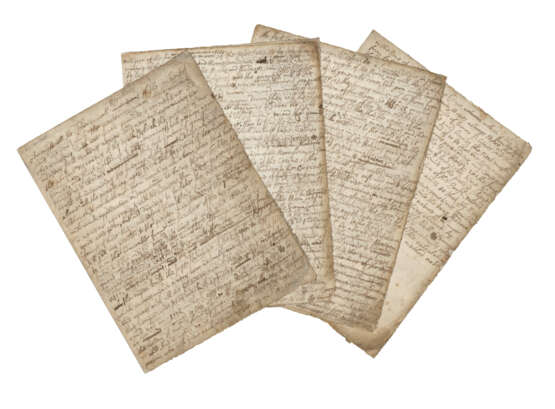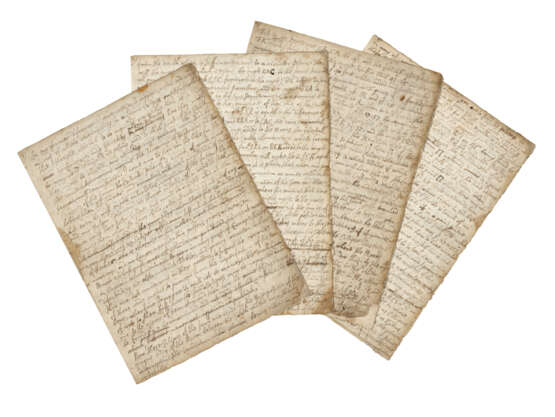ID 1109150
Lot 348 | Edmond Halley (1656-1742)
Estimate value
£ 70 000 – 100 000
Two autograph manuscripts, on lunar and solar eclipses [c.1690-5, probably 1692]
28 pages in total, 211 x 160mm, on 8 bifolia, the first manuscript (on lunar eclipses) of 13.5 pages and the second (on solar eclipses) of 14.5 pages, autograph pagination to the second manuscript, autograph cancellations and emendations across both manuscripts. Red morocco-backed slipcase, cloth folder. Provenance: Arthur A. Houghton, Jnr (1906-1990); his sale, Christie's, 13 June 1979, lot 249.
Two unpublished autograph manuscripts, apparently drafts of papers on lunar and solar eclipses to be read before the Royal Society: mentioning famous eclipses of the 17th century, contemporaries Hevelius and Flamsteed, and the appearance of eclipses in the New World. Autograph manuscripts by Halley have appeared only twice in international auction records. The first paper gives a detailed explanation of the eclipse of the moon, together with the history of eclipses of the past and the method of estimating those of the future; a page of calculations regarding the eclipse of 23 April 1661 is found on the verso of the final leaf. Halley refers to Ptolemy, Euclid, Tycho Brahe, Robert Hooke, Kepler, Horrocks, Hevelius and Flamsteed and quotes from a manuscript of Kepler, which he examined while visiting Hevelius. The eclipse of 19 October 1678 is described in detail and he mentions that it could have been seen in unknown parts of the world – the western part of America, ‘New Found Land’ and ‘Terra de Labrador’. Opening: ‘Amongst the many Astronomicall Hypotheses of the antients there are few which the greater accuracy of the modern observators has not given grounds to reject; time and industry still making nearer and nearer approaches to the perfect discovery of the truth, to which the grossness of our senses and shortsightedness of our reasoning will perhaps never permit us to attain’; concluding: ‘I intend, God willing, to give you a discourse of the calculation and construction of Solar Eclipses after a new method not hithertoo published’. The second manuscript, dealing with solar eclipses, is similar in form to the first and includes a description of the eclipse of the sun on 29 March 1652, ‘commonly called black Monday, the Memory whereof is still fresh among some’. Opening: ‘In my former discourse I gave you, as I suppose, a full and accurate account of all the observables in Lunar Eclipses, omitting nothing that I thought needful to be inquired concerning them, as to their continuance, any quantity wherein shewed how they might be accurately deliniated in […], and to what part of the Earth they might be visible. I come now to shew you the like for the Eclipses of the Sunn’.
The two manuscripts appear to be unpublished drafts of papers read by Halley before the Royal Society in 1692. There is a possible reference to them in Correspondence and Papers of Edmond Halley, ed. E.F. MacPike (1932); in Appendix VIII, ‘Extracts Referring to Halley from the Journal Books to the Royal Society’, it states that Halley ‘gave an account of the Eclipse of the Sun and Moon to bee computed by an easy Calculus’ (2 November 1692) and ‘he shewed a Paper wherein he had computed the Eclipse of the Moon in severall Series’ (9 November 1692). A short autograph manuscript on the same topic – ‘An account of an Observation of an Eclipse of the Moon observed at Moscau in Russia on Aprill 25 1688’ – is now held by the Royal Society (CLP/21/21). The dating of the manuscripts to the early 1690s, even if they are not those referred to by MacPike, is confirmed by the contents of the first. Halley writes of ‘The Mighty Volume [Prodromus Astronomiae, 1690] lately published by the famous Hovalius of Dantsich’ and ‘the most accurate of the last five years observations which his Majesties Astronomer and my honoured friend Mr. John Flamsteed designs for the press’. The latter undoubtedly refers to the observations begun by Flamsteed about 1689, which Halley later edited for publication in 1712.
The only other autograph manuscript by Edmond Halley to have been offered at international auction, according to Rare Book Hub, was a notebook containing chemical and medical recipes, which sold from the Macclesfield Collection in 2004 for £50,400 (Sotheby’s, 11 April 2004, lot 969).
| Address of auction |
CHRISTIE'S 8 King Street, St. James's SW1Y 6QT London United Kingdom | |||||
|---|---|---|---|---|---|---|
| Preview |
| |||||
| Phone | +44 (0)20 7839 9060 | |||||
| Buyer Premium | see on Website | |||||
| Conditions of purchase | Conditions of purchase |






